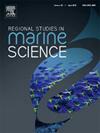马来西亚半岛的海洋微塑料污染:荟萃分析
IF 2.1
4区 环境科学与生态学
Q3 ECOLOGY
引用次数: 0
摘要
海洋微塑料污染最近成为马来西亚半岛一个严重的环境问题。由于之前相关研究在这些地区的时空覆盖范围有限,半岛西部(马六甲海峡)和东部沿海水域(南中国海)的这些海洋微塑料的总体概况仍然模糊不清。本研究通过实施元分析,分析了马来西亚半岛两个沿海水域中海洋微塑料的丰度、形状、颜色、大小、聚合物类型和污染负荷指数(PLI)的最新空间分布。总体而言,揭示了半岛两个沿海水域海洋微塑料的不同分布。西部沿海海域平均海洋微塑料丰度和PLI(41.592颗粒/L;PLI = 997.80)高于东部地区(0.715颗粒/L;PLI = 12.91),这对应于在半岛内几个高度发达的国家,密集的人为活动导致了较高的海洋微塑料污染。西部海域以片状(38.62 %)和膜状(37.46 %)微塑料为主,东部海域以纤维状(84.25 %)微塑料为主。在颜色、大小和聚合物类型分布方面,透明、黑色和白色微塑料;500 ~ 1000 μm的微塑料;在这两个沿海水域中,聚乙烯和聚丙烯基微塑料最为普遍。两种沿海水域海洋微塑料的来源和运输主要受到动力、地理条件、微塑料特性、食物链和人为活动等复杂因素的驱动。因此,严格执行塑料废物管理政策对于解决马来西亚半岛的海洋微塑料污染至关重要。本文章由计算机程序翻译,如有差异,请以英文原文为准。
Marine microplastic pollution in Peninsular Malaysia: A meta-analysis
Marine microplastic pollution has recently become a serious environmental issue in Peninsular Malaysia. The overall overview of these marine microplastics in both western (Strait of Malacca) and eastern coastal waters (South China Sea) of the peninsula remains obscure due to the restricted spatio-temporal coverage of previous relevant studies within those areas. This study presents the analyses of most recent spatial distribution of marine microplastics in both coastal waters of Peninsular Malaysia in terms of their abundance, shape, color, size, polymer type, and pollution load index (PLI) by implementing meta-analysis. Overall, varying distribution of marine microplastics across both coastal waters of the peninsula was revealed. Mean marine microplastic abundance and PLI in the western coastal waters (41.592 particles/L; PLI = 997.80) were higher than the eastern counterpart (0.715 particles/L; PLI = 12.91), which corresponds to higher marine microplastic pollution induced by intensive anthropogenic activities in several high-developed states within the peninsula. Fragment-shaped (38.62 %) and film-shaped microplastics (37.46 %) were predominant in western coastal waters, whereas it was fiber-shaped microplastics (84.25 %) in the eastern counterpart. In terms of color, size, and polymer type distributions, transparent-, black-, and white-colored microplastics; microplastics with sizes of 500–1000 μm; and polyethylene- and polypropylene-based microplastics were the most prevalent in both coastal waters. The sources and transportation of marine microplastics in both coastal waters are mainly driven by a complex combination of dynamic forces, geographical conditions, microplastic properties, food chain and anthropogenic activities. Stringent implementation of plastic waste management policies is thus vital to address the marine microplastic pollution in Peninsular Malaysia.
求助全文
通过发布文献求助,成功后即可免费获取论文全文。
去求助
来源期刊

Regional Studies in Marine Science
Agricultural and Biological Sciences-Ecology, Evolution, Behavior and Systematics
CiteScore
3.90
自引率
4.80%
发文量
336
审稿时长
69 days
期刊介绍:
REGIONAL STUDIES IN MARINE SCIENCE will publish scientifically sound papers on regional aspects of maritime and marine resources in estuaries, coastal zones, continental shelf, the seas and oceans.
 求助内容:
求助内容: 应助结果提醒方式:
应助结果提醒方式:


